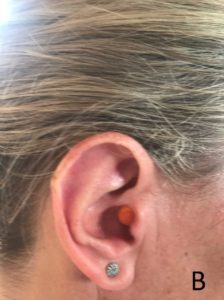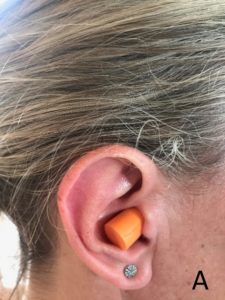Are you a lover of sleep?
Or swimming?
Or going to loud concerts?
Or hunting and shooting?
You might need earplugs.
There’s a wide range on the market and can run you from a dollar or two, up to a several hundred dollars. Noise reduction ratings (NRR) vary from 15 to 30+ dB. (decibels)
How do you choose?
Here’s what you need to know.
FOAM PLUGS
The cheapest and most easily available plugs on the market are the disposable foam earplugs. My gym offers these free from a dispenser on the wall. These are a quick and easy option and can bring noise levels down 15-30 dB. Why the range? It depends on whether you insert them correctly, and whether they fit your ears properly.
To insert them properly you need to roll the plug between your fingers to squish it down, then insert in your ear so the outside edge is flush with the opening of your ear canal, and hold your finger on it while it expands (usually about 10-15 seconds).

 If more than 5mm is visible then it’s not in deep enough. Option B is correctly inserted. Option A is not even close!
If more than 5mm is visible then it’s not in deep enough. Option B is correctly inserted. Option A is not even close!
Ear canals vary – so if it hurts you to put a plug this deep then this style might not suit you or you could have wax or other obstructions in your ear.
See your local Audiologist for a check.
REUSABLE, WAX/MOULDABLE SILICONE NON-CUSTOM EARPLUGS
These are a good option if you want to use your earplugs more than once or twice. Again, properly sealing the ear canal is key to getting full protection. This style of plug is good for swimming because they stick to the skin and don’t absorb water. Some people also find them more comfortable for sleeping because they are soft. Switch to a new pair when they start to get hard or dirty.
Are you a surfer? I recommend using BluTak. Yes, the stuff you used to stick up posters on the wall. It’s super sticky and will stay in your ears even in cold water, or if you wipe out.
REUSABLE NON-CUSTOM PLUGS
You may have seen these on the shelf at your local pharmacy. They look a bit like a mushroom or a Christmas tree: soft caps stuck on a stalk to insert. Some people swear by these, others find them uncomfortable. Some of these offer filters for music or flying. You just have to try them to see if they suit you, and again, proper insertion is important.
CUSTOM EARPLUGS
These are the gold standard because they are custom made to fit properly in your ears and are usually very comfortable. Your Audiologist will take an impression of your ear and order them in. If fitted and inserted properly these offer about 28dB NRR.. Some can be made with a cord so you can hang them round your neck when not using, and swim plugs can be made with an air bubble inside so they float. You can wash them with mild soap and warm water. They should last a year or two depending on how often you use them.
Custom plugs can be made with different filters in them to allow some sound through and reduce distortion. This can be useful for musicians who want a flat attenuation (less distortion in the high pitches). Talk to your local Audiologist about options.
ELECTRONIC HUNTING/SHOOTING CUSTOM PLUGS
These are custom plugs that include an electronic microprocessor to stop loud sounds (gunshots) but allow softer sounds (speech and ambient noise) to pass through. They are pricey, but could be worth it if you are an avid sportsperson and solid plugs don’t work for you.
See your local Audiologist to get your ear canals checked for wax, check your hearing and for more information on hearing protection.
 For more information about hearing, communication and hearing aids you can contact Teresa Burns, Audiologist and Owner of Teresa Burns Hearing Ltd, Auckland New Zealand.
For more information about hearing, communication and hearing aids you can contact Teresa Burns, Audiologist and Owner of Teresa Burns Hearing Ltd, Auckland New Zealand.
+64 (09) 475 9849 or teresaburnshearing.co.nz




